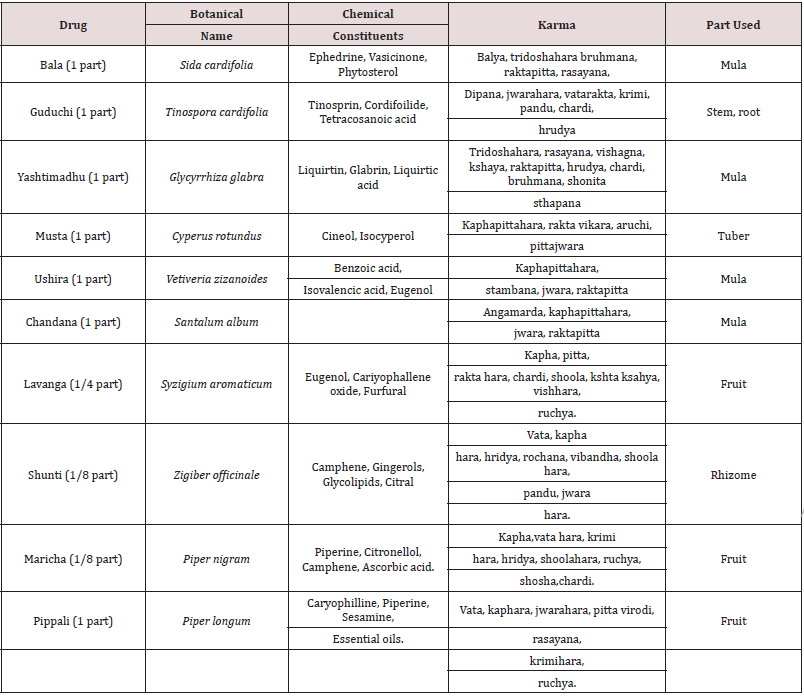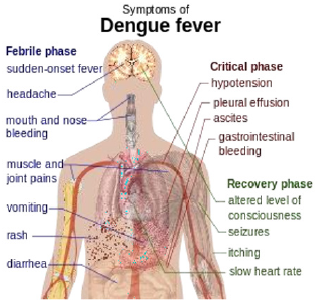
Lupine Publishers Group
Lupine Publishers
Menu
ISSN: 2644-1217
Research ArticleOpen Access
Clinical Efficacy of Balaguduchyadi Kashaya in Dengue Fever in School Students Volume 2 - Issue 2
Vaidya Rohit Mehta*, Bhavya S and Monika Guatam
- Department of Medicine, Kayakalp (Himalayan Research Institute for Naturopathy & Yoga), India
Received: December 17, 2019; Published: January 08, 2020
*Corresponding author: Vaidya Rohit Mehta, Department of Medicine, Panchakarma Vivekanand Medical Research Trust, Kayakalp (Himalayan Research Institute for Naturopathy & Yoga), Palampur, Kangra, Himachal Pradesh, India
Abstract
Dengue fever is communicable disease caused by dengue virus called Aaegepti spread by mosquito, so there is no vaccine and it is particularly difficult to create vaccine because it is caused by different virus and no animal models available for testing. It is also called as ‘breakdown fever’ and ‘dandy fever’ [1-2]. Approximately 390 million people worldwide infected each year and the disease kills over 5000 Indians every year and is a seasonal threat particularly during monsoon. Symptoms will manifest in 3 phases febrile phase-high fever(104.F), muscle and joint pains, headache, measles like rashes, nausea, vomiting, bleeding from mucous membrane of mouth and nose, decreased platelets within 2-7 days, critical phase – blood in vomitus, dark colored stools, severe abdominal pain, restlessness which leads to serious complications and even death and recovery phase [3-4]. As it is caused by virus, so there is no specific medicine or antibiotic to treat it. For typical dengue fever, treatment is purely concerned with relief of symptoms.
In Ayurveda there are several yoga’s which overcome this disease, one such preparation is Balaguduchyadi kashaya – a anubhuta yoga found more effective, consists of bala, guduchi, yashti madhu, musta, chandana, trikatu etc. drugs are having tikta pradhana madhura rasa, sheeta teekshna guna and contains properties like jwaragna, tridoshahara, rasayana, hrudya, balya raktapittahara and proved to be having anti pyretic, analgesic, anti microbial, anti typhoid, immunomodulatory, muscle relaxant properties also. The study was conducted on 10 Students by giving Bala guduchyadi kashaya in the dose of 15ml with honey 2 hourly once for 3 days and then decreased gradually up to 1 week, reduction in signs and symptoms of the disease along with gross increase in platelets within 2 days were noticed. Statistical paired t test is applied which revealed significant result.
Keywords: Dengue; Platelet count; Bala guduchyadi kashaya
Introduction
Dengue fever is one of the life threatening diseases caused by dengue virus (Flavivirus) that is borne and transmitted by mosquitoes within the genus Aedes, principally A. aegypti. Dengue is prevalent throughout the tropics and subtropics. It infects 50 to 390 million people worldwide a year, leading to half a million hospitalizations and approximately 25,000 deaths. There are approximately 390 million people worldwide infected with the dengue virus each year. Approximately 2.5 billion people, or twofifths of the world’s population, are now at risk from dengue which has following symptoms like: In Ayurveda the symptoms of these three phases can be seen accordingly like febrile phase: dainya, udwega, chardi, arochaka, bahistapa, angamarda of rasa dhatugata jwara1, critical phase: rakta, ushna pidaka, sarakta shtivana muhu, daha, raga, brama of rakta dhatugata jwara2 and recovery phase: vireka vamane ubhe, asthi bheda, gatra vikshepana, shwasa of asthigata jwara3 Grossly symptoms of dengue fever can be seen as kshane daha kshane sheeta, asthi sandhi shiro ruja, sasrava rakta, nirbugne darshana, kanta shuka, avruta, kasa, shwasa, aruchi, shtivanam raktapitta, trushna, nidranasha, hrudi vyatha, kota, shyava rakta mandala of sannipata jwara4.
Need for ayurvedic therapies
There is currently no vaccine for dengue fever. Because it is caused by a virus, there is no specific medicine or antibiotic to treat it. For typical dengue fever, the treatment is directed toward relief of the symptoms. Prevention thus depends on control of and protection from the bites of the mosquito that transmits it.
Objectives of the study
a) To evaluate the efficacy of Balaguduchyadi kashaya in symptoms of Dengue fever.
b) To evaluate the efficacy of Balaguduchyadi kashaya on platelet count in Dengue fever.
Materials and Methods
Source of data
10 Students of Dengue fever coming under the inclusion criteria were selected for the study.
Method of collection of data
This is an observational clinical study with pre-test & post-test design where in 10 diagnosed Dengue fever students of either sex were taken for study.
Following statistical methods was employed for the data collected-Paired sample ‘t’ test.
Diagnostic criteria
High grade fever with chills
a) Fatigue.
b) Headache.
c) Fibromyalgia.
d) Decreased platelet count.
Inclusion criteria
a) Students presenting with the sign and symptoms of Dengue fever.
b) Students of either sex.
c) Students between the age up to 18 years were selected for the study.
Exclusion criteria
a) Students suffering with any other serious systemic illness.
b) Platelet count below 30,000.
c) Students with severe hemorrhage.
d) Students with severe rashes.
e) Students with Dengue shock syndrome.
Design of the study
It is an observational study of Balaguduchyadi kashaya in the management of Dengue fever where in pre-test and post-test design was done. Minimum of 10 Students were selected for the study.
Duration of the study
The duration of study ranges from 3 to 7 days or until raise in platelet count and follow up is up to 21 days. Intervention.
Method of preparation
One part of Kashaya churna was taken and 4 parts of water was added and reduced to half part and then it is filtered. Daily fresh kashaya was prepared and used.
Method of administration
Dose of Balaguduchyadi kashaya was 15ml for every 2hrs in a day with 5 ml of honey for 3-7 days. Then duration should be reduced to 4th hrly for next 7 days, then twice daily for next 7 days.
Assessment criteria
The following Subjective and Objective parameters was assessed using different grading and scoring methods before and after the treatment.
Fever
0 – 98.F
1 – 99.F – 100.F
2 – 101.F – 102.F
3 – 103.F – 104.F
4 - > 104.F
Fibromyalgia
a) No pain at rest and working.
b) No pain at rest and mild pain while working.
c) Mild pain at rest and moderate pain while working 3 – severe pain disturbs sleep.
d) Intolerable pain.
Fatigue
a) No fatigue.
b) Mild fatigue after work.
c) Moderate fatigue after work 3 – severe fatigue after work.
d) Severe fatigue without work.
Platelet count
4 - < 50,000
3 – 51000 – 1 lakh
2 – 1,11000 – 1,50000
1 – 1,51000 – 2 lakh
0 - >2 lakh
Discussion
The World Health Organization’s 2009 classification divides Dengue fever into two groups: uncomplicated and severe (Table 1). Dengue can affect anyone but tends to be more severe in people with compromised immune systems. Because it is caused by one of five serotypes of virus, it is possible to get Dengue fever multiple time. Regarding its pathology Dengue virus is primarily transmitted by Aedes mosquitoes, particularly A. aegypti. These mosquitoes usually bite during the day, particularly in the early morning and in the evening, and thus spread infection at any time of day all during the year (Figure 1). When a mosquito carrying dengue virus bites a person, the virus enters the skin together with the mosquito’s saliva (Table 2). It binds to and enters white blood cells and reproduces inside the cells while they move throughout the body. The white blood cells respond by producing a number of signaling proteins, such as cytokines and interferons, which are responsible for many of the symptoms, such as the fever, headache, rashes, severe pains and decreased blood platelet count are seen. Balaguduchyadi kashaya is one such anubhuta yoga is having an ideal combination to prevent.
Dengue fever for the reasons
a) it is having bala, ushira, chandana, lavanga contains rakta shodaka, stambana, raktapittahara effect which purifies the blood and stops bleeding.
b) it is having guduchi, musta, maricha contains krimihara, bhutahara i.e., antiviral, antimicrobial effect which cures infection caused by virus.
c) it is having guduchi, yashtimadhu, pippali contains tridoshahara, balya, bruhmana, rasayana, ojovruddhi i.e., antioxidant, immunomodulatory effect which rejuvenates the body by improving natural or innate immunity. Thus, it is proved to be effective.
Results
The observations made during the study were quite interesting. This study is mainly taken by concentrating on increase in platelet count. As per the medical report of Students the number of platelets had increased within the prescribed time (48hrs) of drinking Balaguduchyadi kashaya in all 10 Students of dengue (Table 3). The increase in number of platelets varied from Student to Student that ranged from 30,000 up to normal. The dengue Students had reiterated that there was a significant improvement in their signs and symptoms within 48 hrs of taking kashaya.
Conclusion
Preventive measures should be taken before spreading of any kind of disease including dengue fever (Table 4). The dengue mosquitoes breed in relatively fresh water, lives close to human habitations and bites during the day and one should be cautious accordingly. In case of travelers returning from endemics and in homes of infection preventive measures should be taken (Table 5). So as preventive measure also Balaguduchyadi kashaya can be administered for 21 days twice daily. So Balaguduchyadi kashaya is helpful in both curative and preventive aspect.
References
- Agnivesha, Charaka Samhita, Charaka, Drdhabala (2010) Ayurveda Dipika Commentry of Chakrapani Datta. In: Vaidya Jadavji Trikamji Acharya (Edt.), Chowkhamba Krishnadas Academy Varanasi, Reprint-2010, Chikitsasthana, Chapter- 3, Verse-76, pp-136-738.
- Agnivesha, Charaka Samhita, Charaka, Drdhabala (2010) Ayurveda Dipika Commentry of Chakrapani Datta. In: Vaidya Jadavji Trikamji Acharya (Edt.), Chowkhamba Krishnadas Academy Varanasi, Reprint-2010, Chikitsasthana, Chapter- 12, Verse-77, pp-136-738.
- Agnivesha, Charaka Samhita, Charaka, Drdhabala (2010) Ayurveda Dipika Commentry of Chakrapani Datta. In: Vaidya Jadavji Trikamji Acharya (Edt.), Chowkhamba Krishnadas Academy Varanasi, Reprint-2010, Chikitsasthana, Chapter- 3, Verse-80, pp-137-738.
- Agnivesha, Charaka Samhita, Charaka, Drdhabala (2010) Ayurveda Dipika Commentry of Chakrapani Datta. In: Vaidya Jadavji Trikamji Acharya (Edt.), Chowkhamba Krishnadas Academy Varanasi, Reprint-2010, Chikitsasthana, Chapter- 3, Verse-103-107, pp-148-738.

Top Editors
-

Mark E Smith
Bio chemistry
University of Texas Medical Branch, USA -

Lawrence A Presley
Department of Criminal Justice
Liberty University, USA -

Thomas W Miller
Department of Psychiatry
University of Kentucky, USA -

Gjumrakch Aliev
Department of Medicine
Gally International Biomedical Research & Consulting LLC, USA -

Christopher Bryant
Department of Urbanisation and Agricultural
Montreal university, USA -

Robert William Frare
Oral & Maxillofacial Pathology
New York University, USA -

Rudolph Modesto Navari
Gastroenterology and Hepatology
University of Alabama, UK -

Andrew Hague
Department of Medicine
Universities of Bradford, UK -

George Gregory Buttigieg
Maltese College of Obstetrics and Gynaecology, Europe -

Chen-Hsiung Yeh
Oncology
Circulogene Theranostics, England -
.png)
Emilio Bucio-Carrillo
Radiation Chemistry
National University of Mexico, USA -
.jpg)
Casey J Grenier
Analytical Chemistry
Wentworth Institute of Technology, USA -
Hany Atalah
Minimally Invasive Surgery
Mercer University school of Medicine, USA -

Abu-Hussein Muhamad
Pediatric Dentistry
University of Athens , Greece

The annual scholar awards from Lupine Publishers honor a selected number Read More...










